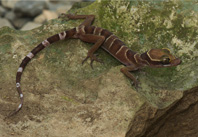Abstract
Paraneoptera is a group of orders, representing one of the highly diverse clades of winged insects. Paleozoic and Mesozoic fossil paraneopterans include a few primitive species, which are significant for understanding the early evolution of Paraneoptera. Here we report a new genus and species, namely Burmopsylla maculata gen. et sp. nov. from the mid-Cretaceous (ca. 99 Myr) amber of Myanmar. The new genus belongs to the family Archipsyllidae by having hindwing similar to forewing (shape, size and venation), presence of forewing ra-rp, rp-m and cua-cup crossveins, two-branched R, four-branched M, and four-segmented tarsus. The new species represents the second species of Archipsyllidae in Cretaceous Burmese amber.
References
Carpenter, F.M. (1992) Treatise on Invertebrate Paleontology Part R, Arthropoda 4: Superclass Hexapoda 3. pp. 1–277.
Grimaldi, D. & Engel, M.S. (2005) Evolution of the insects. Cambridge University Press, Cambridge, 755pp.
Huang, D.Y., Nel, A., Azar, D. & Nel, P. (2008) Phylogenetic relationships of the Mesozoic paraneopteran family Archipsyllidae (Insecta: Psocodea). Geobios 41, 461–464.
http://dx.doi.org/10.1016/j.geobios.2007.11.003Lienhard, C. (2003) Nomenclatural amendments concerning Chinise Psocoptera (Insecta), with remarks on species richness. Revue suisse de Zoologie 110, 695–721.
http://dx.doi.org/10.5962/bhl.part.80207Misof, B., Liu, S., Meusemann, K., Peters, R.S., Donath, A., Mayer, C., Frandsen, P.B., Ware, J., Flouri, T., Beutel, R.G., Niehuis, O., Petersen, M., Izquierdo-Carrasco, F., Wappler, T., Rust, J., Aberer, A.J., Aspöck, U., Aspöck, H., Bartel, D., Blanke, A., Berger, S., Böhm, A., Buckley, T.R., Calcott, B., Chen, J., Friedrich, F., Fukui, M., Fujita, M., Greve, C., Grobe, P., Gu, S., Huang, Y., Jermiin, L.S., Kawahara, A.Y., Krogmann, L., Kubiak, M., Lanfear, R., Letsch, H., Li, Y., Li, Z., Li, J., Lu, H., Machida, R., Mashimo, Y., Kapli, P., McKenna, D.D., Meng, G., Nakagaki, Y., Navarrete-Heredia, J.L., Ott, M., Ou, Y., Pass, G., Podsiadlowski, L., Pohl, H., von Reumont, B.M., Schütte, K., Sekiya, K., Shimizu, S., Slipinski, A., Stamatakis, A., Song, W., Su, X., Szucsich, N.U., Tan, M., Tan, X,, Tang, M., Tang, J., Timelthaler, G., Tomizuka, S., Trautwein, M., Tong, X., Uchifune, T., Walzl, M.G., Wiegmann, B.M., Wilbrandt, J., Wipfler, B., Wong, T.K., Wu, Q., Wu, G., Xie, Y., Yang, S., Yang, Q., Yeates, D.K., Yoshizawa, K., Zhang, Q., Zhang, R., Zhang, W., Zhang, Y., Zhao, J., Zhou, C., Zhou, L., Ziesmann, T., Zou, S., Li, Y., Xu, X., Zhang, Y., Yang, H., Wang, J., Wang, J., Kjer, K.M. & Zhou, X. (2014) Phylogenomics resolves the timing and pattern of insect evolution. Science, 346, 763–767.
http://dx.doi.org/10.1126/science.1257570Nel, A., Prokop, J., Nel, P., Grandcolas, P., Huang, D.Y., Roques, P., Guilbert, E., Dosta, O. & Szwedo, J. (2012) Traits and Evolution of Wing Venation Pattern in Paraneopteran Insects. Journal of Morphology, 273, 480–506.
http://dx.doi.org/10.1002/jmor.11036Nel, P., Retana-Salazar, A.P., Azar, D., Nel, A. & Huang, D.Y. (2014) Redefining the Thripida (Insecta: Paraneoptera). Journal of Systematic Palaeontology, 12, 865–878.
http://dx.doi.org/10.1080/14772019.2013.841781Özdikmen, H. (2009) Psocopsylla nom. nov., a new name for the preoccupied psocid genus Eopsylla Vishniakova, 1976 (Psocodea: Psocidiidae). Munis Entomology & Zoology, 4, 613.
Rasnitsyn, A.P. (2002) Superorder Psocidea Leach, 1815. pp.125–142. In: Rasnitsyn, A.P. & Quicke, D.L.J. (Eds.), History of Insects. Kluwer Academic Publishers, Dordrecht, Boston, London, 517pp.
http://dx.doi.org/10.1007/0-306-47577-4Shi, G., Grimaldi, D.A., Harlow, G.E., Wang, J., Wang, J., Yang, M., Lei, W., Li, Q. & Li, X. (2012) Age constraint on Burmese amber based on U-Pb dating of zircons. Cretaceous Research, 37, 155–16.
http://dx.doi.org/10.1016/j.cretres.2012.03.014Simthers, C.N. (1972) The classification and phylogeny of the Psocoptera. Memoirs of the Australian Museum, 14, 1–349.
http://dx.doi.org/10.3853/j.0067-1967.14.1972.424Trautwein, M.D., Wiegmann, B.M., Beutel, R., Kjer, K.M. & Yeates, D.K. (2012) Advances in Insect Phylogeny at the Dawn of the Postgenomic Era. Annual Review of Entomology, 57, 449–468.
http://dx.doi.org/10.1146/annurev-ento-120710-100538Vishniakova, V.N. (1976) Relict Archipsyllidae (Insecta: Psocoptera) in the Mesozoic fauna. Paleontological Journal, 10, 180–188.
Yoshizawa, K. (2005) Morphology of Psocomorpha (Psocodea: 'Psocoptera'). Insecta Matsumurana, 62, 1–44.
http://dx.doi.org/10.11646/zootaxa.4079.2.5Yoshizawa, K. & Lienhard, C. (2016) Bridging the gap between chewing and sucking in the hemipteroid insects: new insights from Cretaceous amber. Zootaxa, 4079, 229–245.
http://doi.org/10.11646/zootaxa.4079.2.5
Yoshizawa, K. & Saigusa, T. (2001) Phylogenetic analysis of paraneopteran orders (Insecta: Neoptera) based on forewing base structure, with comments on monophyly of Auchenorrhyncha (Hemiptera). Systematic Entomology, 26, 1–13.
http://dx.doi.org/10.1046/j.1365-3113.2001.00133.x
Yoshizawa, K. & Saigusa, T. (2003) Reinterpretations of clypeus and maxilla in Psocoptera, and their significance in phylogeny of Paraneoptera (Insecta: Neoptera). Acta Zoologica, 84, 33–40
http://dx.doi.org/10.1046/j.1463-6395.2003.00127.x
Zhang, Z.Q. (2011) Phylum Arthropoda von Siebold, 1848. Zootaxa, 3148, 99–103.

